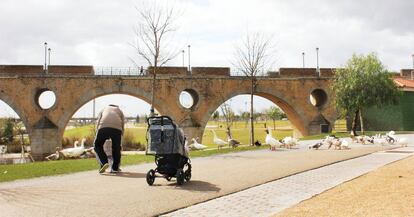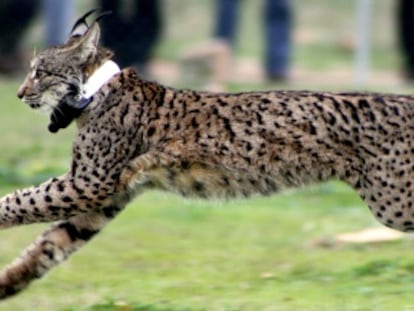Lovable pests? Badajoz wonders what to do with all its geese
A public park in this Spanish city is teeming with fast-multiplying fowl, and experts warn there is a health risk

In 2015, around 40 geese showed up at a new park located along the Guadiana River in the western Spanish city of Badajoz. In 2016 the population expanded, in 2017 it exploded, and this year nobody knows what to do with the geese anymore, because there are already 500 of them. And many more are no doubt on the way, with the arrival of breeding season.
We built this park for the people, not for the geese Mayor Francisco Javier Fragoso
Nobody knows for sure where the geese came from – not city officials, not the regional government of Extremadura, not the area biologists, and not the local residents. But there are two theories.
Around 100 meters from this pretty public park known as Parque del Guadiana, there is another green area that is home to around 60 geese that roam around freely. A few may have escaped and made their way into Guadiana Park, some people feel.
The second theory posits that some people were keeping geese as pets and decided to get rid of them by leaving them in the park. This latter hypothesis is favored by the mayor, Francisco Javier Fragoso of the Popular Party (PP).
“We built this park for the people, not for the geese,” he notes. “They could reach 1,000 specimens by this summer, and that would pose a health risk for the 150,000 residents of the city.”

Animal experts have confirmed that the excess of geese could be potentially harmful for other species and even for people.
“If they keep multiplying, they could be conveyors of avian flu or salmonella,” says José Marín, head of the Badajoz Veterinary Association.
And Marcelino Cardalliguet, the Extremadura representative of the Spanish Ornithological Society, said that while the issue might sound like a joke, it should be taken seriously.
“Since they have no predators nearby, they pose a threat to hundreds of birds such as the squacco heron, which is an endangered species.”
Geese travel in gaggles. In Badajoz, there are groups of between 35 and 40 specimens scattered in various parts of the park. The females lay four to six eggs a year, and the incubation period is 27 to 28 days. Compared with other fowl, they live for a long time, are fast learners, and can be aggressive.
One company wanted to make pâté out of them
Park users are divided over the presence of so many geese. “They never bother me,” says José Antonio, 52, who was out for a run. But over at the children’s playground, Ángel, 34, complains about them as he pushes his daughter Eva on the swings: “It’s all full of excrement. I don’t support eliminating them because the kids love them, but I would reduce their numbers.”
Jana, a 26-year-old waitress at one of two bars located inside the park, was adamant: “They get into the kitchen, they climb up on the tables, they bother the customers and they fill everything with crap. Something needs to be done, now.”
Faced with the controversy, Pablo Ramos, a coordinator at the green group Ecologistas Extremadura, suggests donating them to local farms, while Arturo López, a biologist at the Badajoz Provincial Authority, proposes putting them down. “Yes, I know that will not sound popular. I defend animals too, but they are an invasive species.”
For now, authorities are keeping all options open, including the possibility of capturing and deporting the geese. The use of contraceptive feed was ruled out because other species might eat it, and adoption by local residents is not viewed as acceptable, either.
“This is a problem that stems from the old habit of giving away ducklings as presents,” says José Martínez, president of the Guadiana Water Confederation. “They need to be caught as soon as possible.”
Representatives from this body, from the regional government – which is run by the Socialist Party (PSOE) – and from the city of Badajoz have met twice in the last year in search of solutions, but no agreement has emerged so far.
A bird sanctuary
The zone affected by the overpopulation of geese is part of a Special Protection Area, a EU designation for the conservation of wild birds. The Guadiana River flows very slowly past Badajoz, and this has created a particularly good habitat for several endemic bird, fish and plant species. Conservationists warn that some of these species are under threat from the geese.
“If they don’t do something, this is not going to stop,” says a worker at Joca, the company in charge of conservation and sanitation services at Guadiana Park. “There are thousands of droppings, we never stop cleaning, and it’s breeding season now, so there will be many more.”
A few days ago, the newspaper Hoy reported that the city of Alicante might take a few geese to a local golf course. Don Benito and other municipalities in the area have also expressed an interest. And there is a company that at one point wanted to make pâté out of them.
In the meantime, a group of 36 geese slowly approach the gusanitos (puffed corn snacks) that 40-year-old Victoria has left out on the ground for them, even though feeding the birds is prohibited. “If this park is not for them, who is it for then?”
English version by Susana Urra.
Tu suscripción se está usando en otro dispositivo
¿Quieres añadir otro usuario a tu suscripción?
Si continúas leyendo en este dispositivo, no se podrá leer en el otro.
FlechaTu suscripción se está usando en otro dispositivo y solo puedes acceder a EL PAÍS desde un dispositivo a la vez.
Si quieres compartir tu cuenta, cambia tu suscripción a la modalidad Premium, así podrás añadir otro usuario. Cada uno accederá con su propia cuenta de email, lo que os permitirá personalizar vuestra experiencia en EL PAÍS.
¿Tienes una suscripción de empresa? Accede aquí para contratar más cuentas.
En el caso de no saber quién está usando tu cuenta, te recomendamos cambiar tu contraseña aquí.
Si decides continuar compartiendo tu cuenta, este mensaje se mostrará en tu dispositivo y en el de la otra persona que está usando tu cuenta de forma indefinida, afectando a tu experiencia de lectura. Puedes consultar aquí los términos y condiciones de la suscripción digital.











































